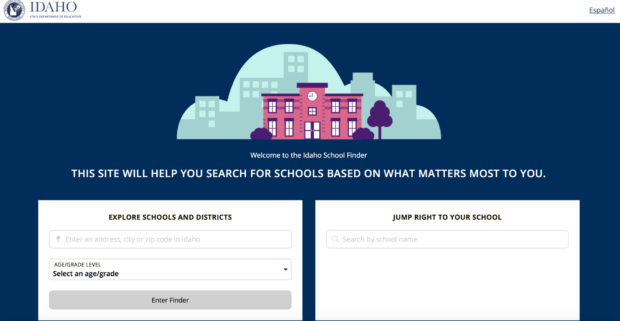The State Department of Education released online report cards for every public school and charter in the state on Wednesday.
The digital report cards are a part of Idaho’s new school accountability system and are available for the public online at www.idahoschools.org. The data included in the report cards isn’t new — it’s been reported out by the SDE over the past several months. What is new is the way the data is presented. In years past, K-12 report cards resembled data spreadsheets and included rows and columns of data. The new report cards released this week feature a sort of homepage for each school. Separate tabs on the report card allow users to access student achievement data, demographics, enrollment, teacher retention, as well as non-academic indicators such as student engagement surveys.

The report cards also feature student achievement targets and percentile rankings, where available for the schools.
Karlynn Laraway, the SDE’s director of assessment and accountability, said the new report cards are designed to be user friendly and provide Idaho families with more information about their public schools.
“The old site was very difficult to navigate and very difficult to look at schools side-by-side,” Laraway said. “There was very little comparative information and absolutely no context for what we were displaying.”
After visiting the report card website, Idahoans can decide whether to review data for a specific school or by city, ZIP code or address.
The report cards allow the public to access information such as standardized test results and high school graduation rates. The report cards also show whether schools were flagged for improvement under the new accountability system.
However, SDE leaders specifically avoided including overall summative ratings, such as letter grades or stars, under the report cards in response to public opposition.
“We simply present the information in a non-biased way and let folks decide for themselves what’s important to them,” Laraway said.
The U.S. Department of Education approved Idaho’s new accountability plan in March. The new accountability plan is important because Idaho has been without an accountability plan since repealing the controversial five-star rating system in 2014.
Under the same accountability plan, the SDE released a list of the state’s lowest-performing schools back in August.
Although the report cards are a new initiative for the SDE, online report cards are not new in Idaho. Four years ago, Idaho Education News launched IdahoEdTrends, which already presents much of the same demographic and student achievement data found in the new SDE report cards. The appearance and search functions of the two sites are similar, allowing users to choose to access data by specific school or by geographic location.
Laraway presented the new K-12 report cards to the State Board of Education on Wednesday afternoon.
“This is a much more fair picture of the elements that make or break success in the school, as opposed to the achievement of students on a single test on a single day,” State Board President Linda Clark said. “I think it will give parents and patrons a much more in-depth look at what’s going on in the schools.”
Earlier in the week, the SDE briefed parent focus groups, as well as education groups including the Idaho School Boards Association, the Idaho Association of School Administrators, the Idaho Commission on Hispanic Affairs, Idaho Business for Education and the Idaho Division of Career Technical Education.
SDE leaders plan to update the K-12 report cards annually in August. However, an interim update is scheduled for January, when the SDE hopes to launch a feature allowing Idahoans to compare up to three different schools at one time, Laraway said.
In using the SDE report cards, Idahoans will occasionally encounter data that has been surpassed, blurred or redacted. Laraway said those redactions were done in accordance with state law and administrative rule in order to protect student privacy.
“We take that very seriously,” Laraway said.
There are a few quirks users will need to get used to. If a parent wants to access a specific school, they need to use the same naming formats and norms the SDE uses in its record keeping system. For example, if a parent types “Boise High School” into the field labeled “Jump Right To Your School,” the system will tell you “no school names match your search” despite the fact there is a very well known school by that name located in Boise’s North End neighborhood.
Instead, that information is found by typing in “Boise Senior High School.” Often, if users pause after typing in the first word of school’s name, a list of suggested schools appears after just a few seconds, which can eliminate some of the guesswork. That tactic gets trickier once you realize state officials allowed several different public schools to name themselves the exact same name. Anyone interested in data on Adams, Roosevelt, Washington, Hillcrest, Mountain View or other commonly named elementary schools will just have to click around through multiple identically named schools to find which exact school they want to access.
The SDE received a grant from the Council of Chief School Officers that covered the approximately $125,000 cost of developing and implementing the first year of the new report cards, Laraway said. The SDE partnered with the data and design firm Tembo to launch the report cards. Idaho Ed News partnered with BrightBytes Labs to launch Idaho EdTrends four years ago.
Parent surveys
In other action Wednesday, the State Board voted unanimously to approve new parent and teacher surveys in conjunction with Idaho’s new accountability system. The surveys will ask parents and teachers about their engagement and satisfaction with their schools. The surveys will be administered this school year, and be similar in nature to student surveys that were launched at the K-8 level last year.
